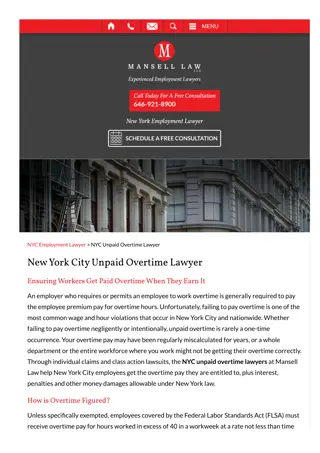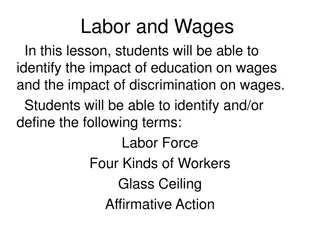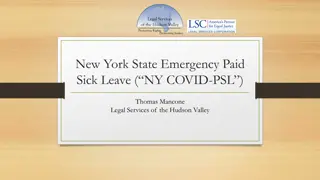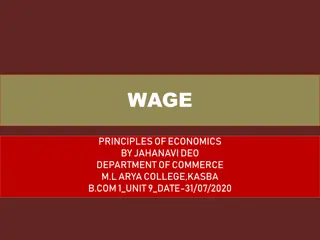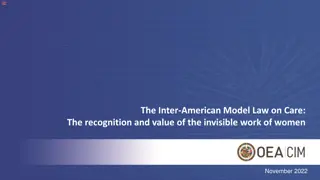Challenges of Unpaid Wages in a Fissured Economy
Non-payment of wages, especially in cases of fissuring where subcontracting and dependence on intermediaries are prevalent, poses a significant issue in employment standards legislation. Better enforcement practices are essential, but the complex scenarios of fissuring make compliance challenging. The Lian Case highlights the difficulties faced by workers in securing their rightful wages in such situations.
Download Presentation

Please find below an Image/Link to download the presentation.
The content on the website is provided AS IS for your information and personal use only. It may not be sold, licensed, or shared on other websites without obtaining consent from the author.If you encounter any issues during the download, it is possible that the publisher has removed the file from their server.
You are allowed to download the files provided on this website for personal or commercial use, subject to the condition that they are used lawfully. All files are the property of their respective owners.
The content on the website is provided AS IS for your information and personal use only. It may not be sold, licensed, or shared on other websites without obtaining consent from the author.
E N D
Presentation Transcript
Rethinking Liability for Unpaid Wages in a Fissured Economy June 25, 2019 LLRN4 Santiago, Chile Professor Kevin Banks Centre for Law in the Contemporary Workplace Queen s University
Outline 1. The problem 2. Current responses (policy models and academic proposals) and their limitations 3. Towards a Canadian variant of a better response
The Problem Non-payment of wages (minimum wages; contractually agreed wages; statutorily required overtime pay) constitutes the single largest group of claims presented to labour inspectors under employment standards legislation the primary venue for wage claims. Better enforcement practices are probably the most important possible response (Banks 2016) But a significant and growing (but hard to measure) fraction of these claims arise in situations where fissuring chronically incentivizes non-compliance and may render enforcement futile.
Three Fissuring Scenarios 1. Subcontracting work previously done by the business 2. Obtaining labour, via contracts with intermediaries, from workers in a position of economic dependence on the business (layering within a somewhat disintegrated enterprise). 3. Directly and indirectly controlling the terms on which obtain an essential input to the business s product (good or service) (supply chains or franchising); as distinct from obtaining a good or service to assist the operation of the business (extended vertical disintegration).
An example the Lian Case L claimed that wages not fully paid, that not paid minimum wage and not paid any overtime or vacation pay by Eliz World total about $5000. EW had hired her to sew garments in her home. EW produced garments for J. Crew, Venator, and Modern Times, through subcontracting arrangements (none had a direct contracting relationship). EW filed no statement of defence.
An example the Lian Case L claimed against EW, and all of the retailers L (with the support of UNITE) led affidavit evidence from industry experts that: Manufacturers were price takers, with retailers setting price quantity and delivery times on a take it or leave it basis. Contractors often subcontract; practice is well known to retailers Buyer-centered production chain very sensitive to market demand and production costs. Court finds that it is reasonable to foresee that there will be ESA compliance problems with some suppliers contractors in this industry.
Current Responses and Their Limitations Existing legislation in Canada Joint employer based on common control and direction Joint and several liability in subcontracting the work of an existing enterprise (Quebec and Saskatchewan) Joint and several liability in agency employment (eg Ontario) Joint and several liability for farm labour contractors (British Columbia)
Current Responses and Their Limitations Other common law jurisdictions Accessorial liability (Australia) Joint employer based on vertical economic dependence (US DOL 2016) Joint and several liability in problematic sectors where knew or ought to have known funds insufficient (California Labor Act s. 2810)
Current Responses and Their Limitations Limitations Normative basis of legal responsibility for unpaid wages not articulated with sufficient precision Scope not congruent with the problem What type of knowledge (actual or constructive) of and/or control over remuneration is/are needed before legal responsibility is justified? Lack of a determinate model of legal responsibility of non- contracting parties leads courts and tribunals to forego extension of responsibility based on purposive interpretation of legislation (as in the Lian case)
Current Responses and Their Limitations Limitations in Action Ontario s 2016 Changing Workplace Review All options in other common law jurisdictions (listed above) on the table in interim report None retained in final report Indeterminacy of purpose and scope of alternative models of liability substantially weakened case for reform in the face of stiff political resistance from employers and other proposals competing for expenditures of political capital.
Towards a Canadian Response to the Problem Potentially receptive legal environment History of purposive interpretation of employment statutes by autonomous administrative tribunals has weakened the hold of traditional common law tests and enabled extension of responsibility beyond contractual relationships Supreme Court s struggles with the definition of employment have led to move away from formalism core of common law test now asks whether the worker is in business for him/her/themselves or not
Towards a Canadian Response to the Problem Steps in analysis Identify principles of legal responsibility of third parties to contracts, beginning with those that are indigenous to the Canadian legal system Outline potential approach Consider practicalities of implementation the retail vs wholesale determination problem
Principles of Legal Responsibility Academic Literature Causation Foreseeability Capacity to prevent Unjust benefit
Principles of Legal Responsibility Canadian Legal System Enabling torts: In general terms, responsibility of third parties in negligence requires that: 1. defendant intentionally attracts and invites parties to an inherent and obvious risk that he or she created and controls (competitions; supplier of an instrument of danger; suppliers of goods and services to consumers; commercial hosts serving alcohol); and 2. fails to take reasonable care to prevent harm
Principles of Legal Responsibility Canadian Legal System Regulatory offenses of permission Only responsible for activities of another if had the ability to control behaviour which could have foreseen and failed to do so Due diligence defence presumptively available if all reasonable care is taken to avoid any foreseeable harm Simply relying on subcontractors to self-regulate is not due diligence Fact-intensive and case-specific determinations
Principles of Legal Responsibility Canadian Legal System Purposive interpretations of health and safety and anti- discrimination law: Responsibility assigned on the basis of capacity to control what harm to be prevented by legislation. Again, very fact-specific determinations Construction liens Legal responsibility imposed without regard to circumstances of control or foreseeability
Towards a Better Approach Knowledge or constructive knowledge requirement A purposive approach would attach legal responsibility to a third party to the contract of hire where that third party knows or ought reasonably to know that there is a substantial risk that legally required remuneration will not be paid to workers producing inputs to the products or services that its business provides. Knowledge could be imputed on the basis of industry circumstances (analogously to inherent and obvious risks in enabling tort law), or inferred from the particular circumstances of the case.
Towards a Better Approach Knowledge Requirements: What We Know About Factors Leading to Non-Payment of Wages Low cost of entry sectors Competition on the basis of labour costs Fluctuations in demand with short response times Fungible labour force
Towards a Better Approach Retail or Wholesale Application? Wholesale or standardized approaches to responsibility and duties only justifiable on the basis of particular industry conditions sector-specific regulation Retail determinations of responsibility and duties likely to be prohibitively expensive and viable only by class action or test case




